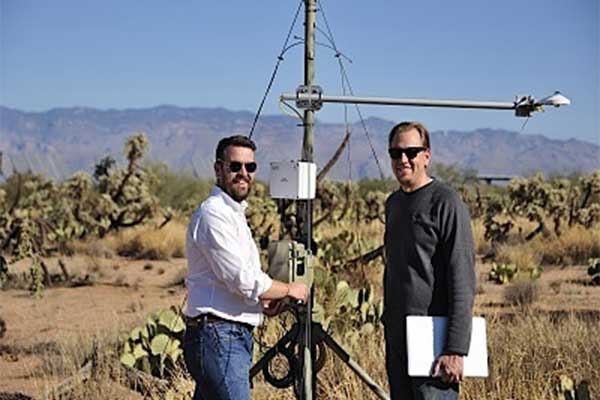Originally published on ResearchGate
Researchers have found that solar power plants raise temperatures in their immediate environments. The study, which appeared in Nature Scientific Reports, revealed that nighttime temperatures over photovoltaic power plants were regularly 3-4 degrees Celsius warmer than in surrounding areas. While these effects are likely offset by the benefits of solar power, lead author Greg Barron-Gafford says it is worth looking at ways to mitigate them. We speak with him about the findings and their implications.
ResearchGate: What led you to conduct this study?
Greg Barron-Gafford: I study how ecosystems respond to changes in their land use and land cover in light of a changing climate. I have been doing this sort of work in natural and managed ecosystems for more than a decade, and wanted to use the same tools and expertise to examine a “built environment”: large-scale photovoltaic areas. We had read that people near intended photovoltaic installations were concerned about potential unintended side-effects of renewable energy production, including worries that photovoltaic power plants could create a heat island effect. We were at an impasse – we couldn’t support or counter these concerns because there were no studies to point to.
RG: What were the results of your study?
Barron-Gafford: We found temperatures over a photovoltaic power plant were regularly 3-4 degrees Celsius warmer than the nearby wildlands at night, confirming the presence of a photovoltaic heat island effect. The degree of this effect varies depending on the season, likely because of changing sun angles and background temperatures. While the photovoltaic heat island effect was detectable in the day, the real significant warming was found in the evening hours, partially because these large photovoltaic installations took longer to cool down in the nighttime hours.
RG: Why does this happen?
Barron-Gafford: We believe that this heat island effect results from the transition in how solar energy moves in and out of a photovoltaic installation versus a natural ecosystem. Basically, there are two ways to “get rid” of heat from solar energy in an environment: latent heat (for example when water transforms from liquid to vapor) or sensible heat (the heat you can feel). When one pathway is reduced, you have an increase in the other. Within natural ecosystems, vegetation reduces heat gain and storage in soils through shading, and energy that is absorbed by vegetation and surface soils can be released as evapotranspiration – the combined water loss from soils (evaporation) and vegetation photosynthesis (transpiration). This heat-dissipating latent energy exchange is dramatically reduced in a typical photovoltaic installation, potentially leading to greater heat absorption by soils. This increased absorption, in turn, could increase soil temperatures and lead to greater sensible heat efflux.
RG: What are the environmental implications of your findings?
Barron-Gafford: More than anything, these findings remind me that we need to be mindful of the implications of our work on the landscape. These results were important because we now have actual field data from a semiarid environment – one of the most common environments for siting large solar photovoltaic plants. Yet, we still lack data on the size of the photovoltaic heat island effect. The size of an urban heat island is determined by properties of the city, including population, spatial extent, and geographic location. We should, similarly, consider the spatial scale and geographic position of a photovoltaic installation when considering the presence and importance of the heat island effect.
We have conducted preliminary research by running a transect of temperature sensors from the heart of an installation outward, and those results suggest that the heat island dissipates within about 30 meters. This might suggest that most of the heat generated simply rises away from the ground surface. To fully contextualize these findings in terms of global warming, we need to consider the relative significance of the (globally averaged) decrease in surface reflecting power due to photovoltaic power plants against the carbon dioxide emission reductions associated with their use. For this reason, I do not see our findings to suggest any reasons to move away from photovoltaics as a valuable part of our renewable energy portfolio. That said, we should see if there are simple ways to mitigate this heat island effect.
RG: Have you looked into any mitigation strategies?
Barron-Gafford: We think there could be significant mitigation potential in simply re-introducing vegetation into these large-scale photovoltaic installations. Thinking back to our understanding of energy balance – how energy from the sun moves in and out of an ecosystem – if we want less sensible heat, we should increase latent heat fluxes like evapotranspiration from water and soil. We have conducted preliminary research in planting areas under photovoltaic panels to reintroduce that latent heat exchange from plant transpiration. We found that this can actually create a cooler environment. These findings are very encouraging, but we have lots of unanswered questions: How well does this scale up to larger installations? How much water is required? How does growing in partial shade influence the plants? What if we go so far as to grow food crops under these panels? These are the next steps we want to pursue in our research. We feel that in identifying the photovoltaic heat island effect, we may have stumbled on a new praxis for maximizing renewable energy production and possibly food crops.
RG: Are there instances where temperature increases caused by solar power plants would be a reason not to build them?
Barron-Gafford: So far, we have not identified a reason to support any hesitation in future solar power plant development. Our preliminary work suggests that the reach of the heat island effect is too small for a solar power plant to affect local homes. We should, though, consider the fact that solar panels become less efficient as they warm, so in a way, the heat island effect could actually be negatively impacting their production. I see this as encouragement to investigate mitigation potentials more than a cause for moving away from solar.












Comments